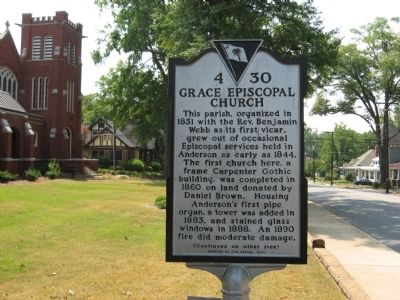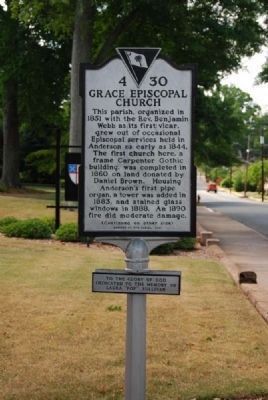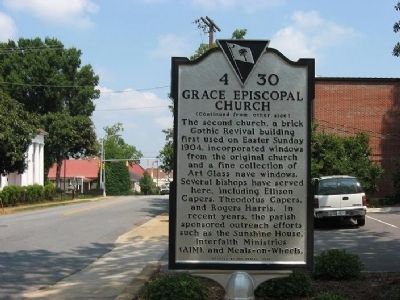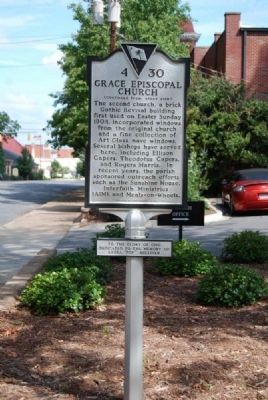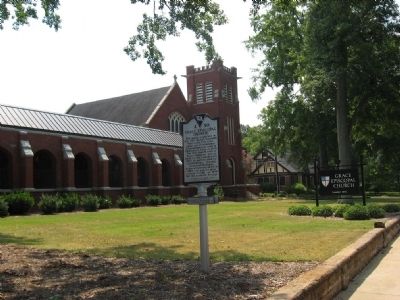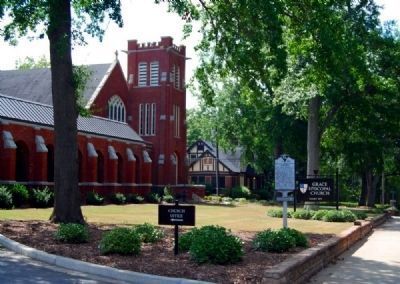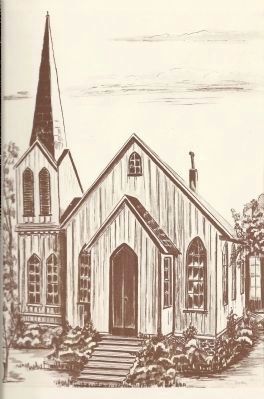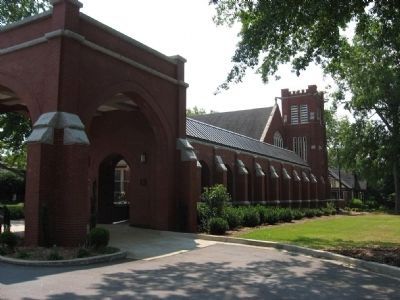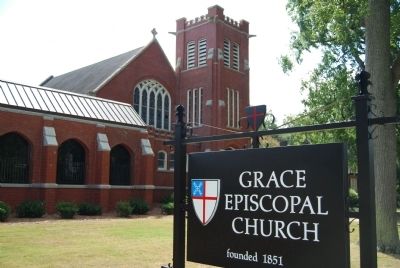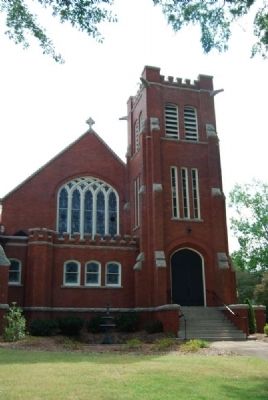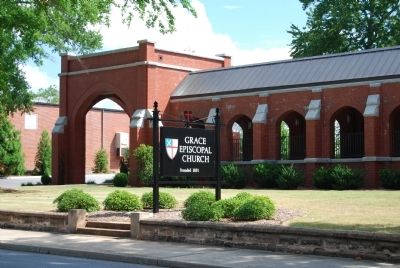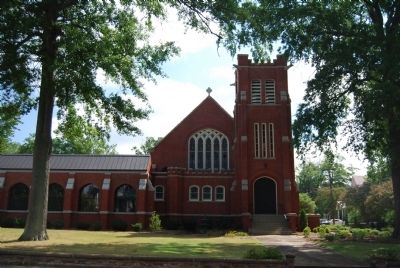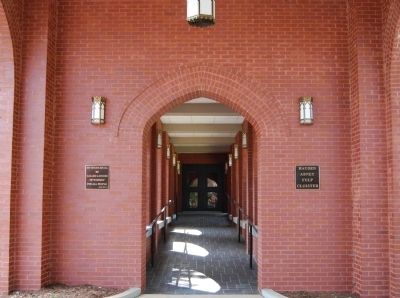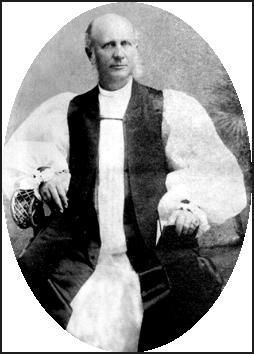Anderson in Anderson County, South Carolina — The American South (South Atlantic)
Grace Episcopal Church
Front
This Parish, organized in 1851 with the Rev. Benjamin Webb as its first vicar, grew out of occasional Episcopal services held in Anderson as early as 1844. The first church here, a frame Carpenter Gothic building, was completed in 1860 on land donated by Daniel Brown. Housing Anderson's first pipe organ, a tower was added in 1883, and stained glass windows in 1888. An 1890 fire did moderate damage.
Reverse
The second church, a brick Gothic Revival building first used on Easter Sunday 1904, incorporated windows from the original church and a fine collection of Art Glass nave windows. Several Bishops have served here. Including Ellison Capers, Theodotus Capers, and Roger Harris. In recent years, the parish sponsored outreach efforts such as the Sunshine House, Interfaith Ministries (AIM), and Meals On Wheels.
Erected 2001 by Grace Episcopal Church Parish. (Marker Number 4-30.)
Topics. This historical marker is listed in these topic lists: Architecture • Churches & Religion. A significant historical year for this entry is 1851.
Location. 34° 29.968′ N, 82° 38.856′ W. Marker is in Anderson, South Carolina, in Anderson County. Marker is at the intersection of South McDuffie Street and East Reed Street , on the left when traveling south on South McDuffie Street. Marker is located on the church grounds near the sidewalk. Touch for map. Marker is at or near this postal address: 711 South McDuffie Street, Anderson SC 29624, United States of America. Touch for directions.
Other nearby markers. At least 10 other markers are within walking distance of this marker. St. John's Methodist Church (about 300 feet away, measured in a direct line); Lynching in America / Lynching in Anderson County (about 700 feet away); G. Ross Anderson Jr. Federal Building and United States Courthouse (approx. 0.2 miles away); A Living Tribute (approx. 0.2 miles away); William Bullein Johnson (approx. 0.2 miles away); After Dark: Seeking Harmony in Music and Culture (approx. 0.2 miles away); More Than Food: Savoring the Flavor of Dignity (approx. 0.2 miles away); In Commemoration of Black Pioneers (approx. 0.2 miles away); The Church Street Heritage Plaza (approx. 0.2 miles away); Anderson County Courthouse Annex Park (approx. 0.2 miles away). Touch for a list and map of all markers in Anderson.
Regarding Grace Episcopal Church. Grace Episcopal Church is one of the key contributing properties in the 1971 listing of the Anderson Historic District in the National Register of Historic Places.
Also see . . .
1. Grace Episcopal Church. The official Grace Episcopal Church website. (Submitted on August 19, 2008, by Kevin W. of Stafford, Virginia.)
2. Anderson Historic District. Anderson came into being in 1826 with the formation of Anderson County, and as a courthouse seat, the community was quick to develop. (Submitted on January 10, 2009, by Brian Scott of Anderson, South Carolina.)
3. Ellison Capers. Ellison Capers (October 14, 1837 – April 22, 1908) was a school teacher, Confederate general in the American Civil War, theologian, and college administrator from South Carolina. (Submitted on January 10, 2009, by Brian Scott of Anderson, South Carolina.)
Additional commentary.
1. Grace Church
Of the two Episcopal churches in the county, historic St. Paul's in Pendleton, is by far the oldest, dating from 1822, but the congregation of Grace Church is far older than its building. At first composed almost entirely of women, among whom were Mrs. Edward Morris, Mrs. Daniel Brown, Mrs. Elijah Webb, and the Misses Mary and Carrie Waller, they met for years in each other's houses except when there was a visiting clergyman. In 1844 there were three services in the Anderson County Court House and later some were held in the Benson Hotel's Long Room. The year 1851 marked the beginning of Grace Church as an organized mission under the leadership of the Rev. Mr. Webb who divided his time between Anderson and Abbeville. The structure to serve the Episcopalians in Anderson was erected in 1868 on land given by Mr. Daniel Brown, who, though a Baptist, then served as its vestryman to handle the little church's financial affairs and attend the Diocesan meetings. The wooden building with its "tall, slender spire pointing to heaven" was described as small but pretty and "churchly." Mr. John Baker of Charleston placed in the new chapel a cabinet organ, the first ever brought to Anderson.
Following the Rev. Mr. Seabrook and the Rev. John Elliott who served during the war years 1861 and 1862, the church was kept alive by the devotion of its women. In 1866 General Ellison Capers was a lay reader and afterwards his son, who became Bishop W.T. Capers of Texas, had as his first charge this same little church in which his distinguished father had served. Both of these men were beloved by the whole community. Another loved and honored rector was the Rev. Thomas Gadsen who served Grace Church longer than any other, from 1877 until his death in 1891. The beautiful west window in the present building is a memorial to him.
The first service in the present building was conducted on Easter Sunday 1904 by Bishop Ellison Capers. The brick and stone structure was erected on the same site under the able direction of Christopher Sayre, and a building committee composed of Dr. S.M. Orr, Fred G. Brown, and R.C. Webb. These last three and C.W. Webb, R.E. Belcher, and E.A. Bell are mentioned in the earliest recorded minutes of vestry meetings. Serving as a warden for many years after the present building was constructed was Judge Milledge Bonham, Chief Justice of the South Carolina Supreme Court.
An interesting footnote as to the conventions of the early days of this community is that in the early congregations other than the Episcopal and the Catholic, it was the custom for the men to sit on one side and the women on the other. (Source: Anderson County Sketches, The Anderson County Tricentennial Committee, 1969.)
— Submitted January 10, 2009, by Brian Scott of Anderson, South Carolina.
2. Grace Episcopal Church
The present structure was erected in 1904, replacing an earlier building on the same site. Bishop Ellison Capers conducted the dedication ceremonies. In the earlier church, Confederate General Ellison Capers was a lay reader and his son, later Bishop W.T. Capers of Texas, had his first charge here. Judge Milledge Bonham, chief justice of the S.C. Supreme Court, was a warden. (Source: Anderson Historic District National Register nomination form.)
— Submitted September 20, 2010, by Brian Scott of Anderson, South Carolina.
3. Obituary for Milledge Lipscomb Bonham, Noted Member of Grace Episcopal
Milledge Lipscomb Bonham
1854-1943
Milledge Bonham served as Judge of the Tenth Circuit from 1924-1931, as an Associate Justice of the South Carolina Supreme Court from 1931-1940, and as Chief Justice of the Supreme Court from 1940-1943. He practiced law in Anderson. He was married to Miss Daisy Aldrich and, following her death, he married Dr. Lillian L. Carter.
He was prominent in politics, fraternal orders, church activities, historical societies, social organizations and organized Bar efforts. The respect accorded him as a man and able lawyer is evidenced by the fact that he was not a member of the Legislature when elevated to the Bench.
"Like the leaders of the Old South, he too, made as his greatest contribution grace and nobility of Character."
— Submitted January 10, 2009, by Brian Scott of Anderson, South Carolina.
4. Rt. Rev. Ellison Capers, D.D.
A man of exalted character and achievement, Bishop Capers' became one of the distinguished prelates of the Protestant Episcopal Church in the South and was the seventh bishop of the Diocese of South Carolina. He was known as "the soldier bishop," and with utmost consistency has it been written that "He was one of the most eminent figures in the South, and hundreds of South Carolinians are proud to claim him as their source of inspiration, whether as teacher, soldier, or Episcopal bishop of South Carolina."
Ellison Capers was born in Charleston, South Carolina, on the 14th of October, 1837, and was a scion of an influential family whose name has been closely and worthily identified with the history of South Carolina since 1694. His grandfather was Captain William Capers, one of "Marion's Men" in the war of the Revolution — "though an officer, still a man; either way an honor." The father of Bishop Capers was an eloquent divine of the Methodist Episcopal Church and one of its first bishops in the South. So it happened long ago that this family became distinguished on the battlefield and in the pulpit.
"Coming events cast their shadows before," but little did the parents of Bishop Capers know of what the future had in store for the child who first saw the light of day in that beautiful city by the sea, a city enclosing, among its quaint old buildings, facts and traditions and memories dear to remembrance. At the age of nine years Ellison Capers became a pupil of Doctor Brumby, head master of a then celebrated school that has honorable record in the history of educational work in South Carolina. In January, 1854, young Capers was nominated for a cadetship at the Arsenal, at that time the training school for the state's historic academy known as The Citadel. During the transformation scene between Arsenal and Citadel life, he endured much, and following the old rule of Rugby, Eaton and West Point, he never "peached" when passing through the ordeal that awaits the young recruit.
Cadet Ellison Capers was graduated at The Citadel as a member of the class of 1857 and became assistant professor of mathematics and belles letters in that institution. At this time also was solemnized his marriage to Miss Charlotte Rebecca Palmer, of St. Johns, Berkeley County, South Carolina. His native state was about entering that struggle for independence which, for a period of four years was to deluge the soil of the South with the best blood of its people. Lieutenant Capers, of The Citadel, at the age of twenty-three years, was elected major of the First Regiment of Rifles. Well, and most faithfully, under Beauregard's command, he rendered service in and around Charleston, and then, having been promoted lieutenant colonel, he entered into more active service for the Confederate states. The campaign on James Island was opened by Lieutenant Colonel Capers. In this engagement Colonel Capers led the attack, and for his courage and skilful management was commended in
general orders, "for distinguished gallantry." At the battle of Secessionville his action again caused him to be mentioned in general orders and in the affair at Clark's House he again received similar recognition, "and always for gallantry," says Brigadier General N.G. Evans. On the 4th of April. 1862, as lieutenant colonel, he went with the Twenty-Fourth Regiment to engage in the campaign at James Island. He commanded this regiment at the battle of Jackson, Mississippi, where he was wounded. At Franklin, Tennessee, he was again wounded, as he was later at the battle of Chickamauga. On March 1, 1865, upon the recommendation of General Johnston and General Hardee, he was commissioned brigadier general, at the age of twenty-eight years.
For a year after the close of the Civil war General Capers was compelled to use crutches, as the result of the wounds he received in battle. Before the war he had been studying law, in spare moments, and had completed the course. In one of the battles in which he took part there came to him a great moment, that was destined to change his career in future. It appeared inevitable to him, in one of the great battles, that his command would be annihilated. He appealed to his Maker in earnest prayer, and gave a vow to God to devote his life forever to His service if He would extricate his men from this massacre. This was the battle of Chickamauga. In 1866 General Capers was elected secretary of state of South Carolina. After serving his state in this capacity, during a political crisis, he resigned to redeem his secret pledge and applied himself for Holy Orders.
In an issue of the Edgefield (South Carolina) Chronicle a layman has written as follows: "Bishop Capers is perhaps the most widely known and most universally beloved man in South Carolina. We do not mean to say that his being bishop over the Episcopal Church in South Carolina makes him thus, although as high and broad a Christian as Bishop Capers is more than apt to be generally appreciated and honored. It is the Bishop's noble record in the Confederate war, joined to his almost perfect personal character, that causes him to be known and be loved on all sides. When the Bishop comes here or goes there or yonder, it is not Episcopal, Methodist, Baptist or Presbyterian—but is 'Bishop Capers is here!' or 'General Capers is here!' or 'Brave old Ellison Capers is here!' And everybody wants to see him and shake his hand—old people, because they know and love him, and young people because they honor and love the traditions; because they would greet a hero of faithful history."
General Butler and General Capers were warm friends; indeed their early acquaintance and friendship soon ripened into a love that lasted throughout the life of the dead soldier and bishop. Close comrades in peace and war, none knew better or had a higher admiration for the lamented dead than his friend and comrade in arms, ex-Congressman Gen. M. C. Butler, who this morning paid the following beautiful tribute to his life-long friend:
"Edgefield, April 26. — Special:
"The death of Bishop Capers leaves but three of the thirty-three general officers in the Confederate armies from this state, Stephen D. Lee, T.M. Logan and myself.
"I do not mean to disparage the high qualities of my two surviving friends and comrades, and trust they will not so regard it, when I say, in my opinion, Capers was a better man than either of us. In his sphere of action there was no more valiant, accomplished soldier in either army. When he was fighting for his convictions as a citizen of a constitutional republic. As a young solder in that fight he flashed his sword with courage and honor under the starry cross, and when that banner was furled he enlisted under the cross of Christ, and took his orders from the Prince of Peace.
"We all know how he devoted the best years of his life in conscientiously, bravely, faithfully carrying out those orders of his Supreme Commander. No higher encomium can be awarded him than to say he was a good citizen, in what is supposed to be a free republic, measuring up to the full height of his responsibilities as such.
"He was a chivalric gentleman, endowed by nature and employed in his daily life, with a grace, a patience and considerate firmness that few men possess.
"The last time I met him we were passengers in the same carriage, going in that imposing procession to the unveiling of the Hampton monument, in Columbia. It was my fortune to be selected to deliver the principal address. Bishop Capers was appointed to open the proceedings with prayer. We all recall the fervor, eloquence, grace and sincerity of his delivery.
"The world can ill afford to spare such men, but like all mortals he had to go, and although not present at the final summons, 1 venture the opinion he met the 'grim spectre' as fearlessly and bravely as he had met every danger and responsibility during his natural life.
"He was not afraid to die—why should he have been? He had discharged every duty to his God and his country, and I believe as firmly as I believe in my own existence that when his purified spirit left its mortal habitation, it took its flight 'straightway to realms of everlasting peace, there to enjoy communion with Bishop Lieut.-Gen. Leonidas Polk, of Tennessee, the Reverend Brigadier General Pendleton, of Virginia, soldiers of the world and of the cross, and other exalted spirits and patriots who had preceded him. He leaves surviving one distinguished comrade in each sphere — the Rev. Gen. Clement A. Evans, of Atlanta, who exemplified in his life the best type of soldier and American citizen. May he be spared many years to continue his high ideals as an example to those who come after him."
In 1867 Ellison Capers became a priest of the Protestant Episcopal Church. For twenty years he served as rector of Christ Church, Greenville, South Carolina. A beautiful memorial window, costing more than $10,000, is now one of the visible testimonials to the love and reverence in which his name is kept in Christ Church. For one year he was at St. Paul's Church, Selma, Alabama. This church, incidental to his consecration as bishop, sent to him the Episcopal ring, with a letter full of appreciation. July 20, 1893, he was consecrated bishop of the South Carolina Diocese of the Protestant Episcopal Church. As he had been six years rector of Trinity Church, Columbia, the consecration services there took place. "Out of his old faith he brought with him all he had found in it that was holy and pure and of good report — not its intolerance, but its zeal; its self-devotion, its heavenly aspirations, its human sympathies.
"Thou hast the nobler virtues of thy race, Without the failings that attend those virtues; Thou canst be strong, and yet not tyrannous, Canst righteous be and not intolerant."
When Ellison Capers died, April 22, 1908, there passed from earth one of the gentlest, sweetest spirits that has ever mingled with the lives of men. Endowed with great physical strength, and with a mind singularly alert, versatile and powerful, he had the heart of a child and the heart of a lion; he was a counselor, guide and staff to the humblest, and to the highest; a soldier in war, a soldier in peace, he was ever erect, resourceful, conquering, yet making all who came under his powerful spell to feel that God at times vouchsafes to man the essence of divinity. In his life, as in his death, he was known as "the best loved man in South Carolina," and the knowledge that he deserved this crown of praise is the heritage of his church and his state.
Following is an extract from an editorial that appeared in the Charleston News and Courier under date of April 23, 1908:
"The bells that yesterday sent out from St. Michael's historic tower the tidings of the death of Bishop Capers have never sounded the knell of one more beloved, admired and respected. They have announced the decease of presidents, and governors and bishops and rectors and others of distinction in state and nation, for six score years and more, but for no man of them all has their reverberating message worked more universal and sincere sorrow. His has been a place unique in his native commonwealth. He touched its life at many points. As citizen, as soldier, as educator, as public official, as bishop, he has met the expectations and justified the confidence of his people, who delighted to do him honor as they followed his progress with sympathetic admiration and growing appreciation, bidding him to one high place after another until at the ' last, as leader of his church's host in South Carolina, they crowned his career of honorable service with the most exalted testimonial of trust and love in their power to offer. For fifteen years as bishop — more truly servant of all than ever before — he so bore himself in his high office as to have won the admiration of his peers, the good will of his fellow Christians of every name, and the devotion of his clergy and people, the respect of all sorts and conditions of men. In Colonel John Thomas' history of the South Carolina Military Academy much of interest is said of 'the most distinguished graduate'. 'Strong alike with clergy and laity, the mantle of larger responsibilities than he has yet borne may, in God's providence, await him in the future. That his mind is strong enough, his soul sweet enough and his shoulders broad enough for heavy church burdens — this would seem attested by his character and career. So many times, on account of his graceful oratory, has he been called upon to address his fellow citizens, especially upon Confederate
occasions that he might fitly be considered as having earned the title of Orator Laureate of the Confederacy."
After the death of Bishop Capers there came to his family many letters from different parts of the United States. As a separate booklet these letters would reveal the impressions of varied lives of men and women in every condition of life—letters from Bishop Weed, of Florida; Bishop Gailor, of Tennessee; Bishop Nelson, of Atlanta, Georgia; Bishop Cheshire, of North Carolina; Bishop Bratton, of Mississippi, and many other letters of deep feeling. An extract from the letter of the late Bishop Potter of New York City shows the attitude of the Northern bishop to the Southern friend. A silver service now in possession of the Capers family was presented to Bishop Capers by Bishop Potter, October 14, 1904, as a birthday remembrance for friendship's sake. Bishop Potter writes: "It casts a somber light upon the church, not alone in South Carolina but also throughout the United States, to learn, as we have done in New York of late, of the death of our dear friend Bishop Capers. He became endeared to some of us for the first time in connection with the General Convention of 1901, which sat, as it will be remembered, in San Francisco, and the undersigned was privileged then to enjoy his society, as his guest in the house which dear friends in San Francisco had placed
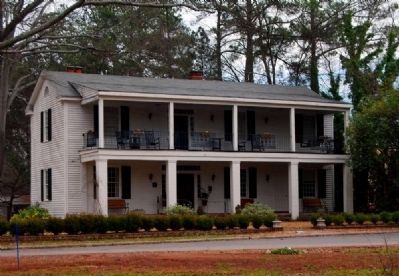
Photographed By Brian Scott, February 21, 2012
16. Gen. Ellison Capers House, c. 1840
216 Moultrie Square
216 Moultrie Square
This house at 216 Moultrie Square was built around 1840. While serving as a Confederate general, Capers was wounded several times and was cited for great bravery. He studied for the ministry after the Civil War and was elevated to Seventh Bishop of the Episcopal Church of South Carolina.
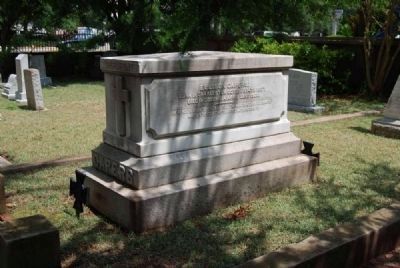
Photographed By Brian Scott, July 25, 2011
17. Ellison and Rebecca Capers Tombstone
Northeast Corner
Trinity Episcopal Church, Columbia, S.C.
Northeast Corner
Trinity Episcopal Church, Columbia, S.C.
Died in Columbia April 22nd 1908
----------
He rendered unto Caesar the things that are Caesar's
and unto God the things that are God's.
At the time of Bishop Capers' death he was survived by his wife and seven children, five sons and two daughters—Francis Fasseaux, John Gendron. William Theodotus, Ellison, Walter Branham, May (Mrs. Charles B. Satterlee), and Lottie (Mrs. William H. Johnson). Of the sons it should be recorded that Rev. Walter B. is president of Columbia Institute, in the State of Tennessee, and author of a life of his father, issued under the title of, "The Soldier Bishop." Hon. John G. Capers, a distinguished lawyer in the City of Washington, D.C., is the subject of an individual sketch on other pages of this work. Perhaps the mantle of Bishop Capers' great goodness has fallen upon his third son, the Rt. Rev. William Theodotus Capers, who is now bishop of the diocese of West Texas, his home being at 106 West French Place, San Antonio, that state. He is eloquent and beloved,
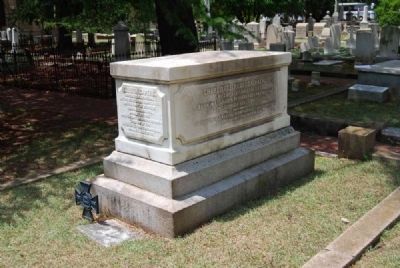
Photographed By Brian Scott, July 25, 2011
18. Ellison and Rebecca Capers Tombstone
Southwest Corner
Trinity Episcopal Church, Columbia, S.C.
Southwest Corner
Trinity Episcopal Church, Columbia, S.C.
Brigadier General
in the Southern Confederacy
Secretary of State of
South Carolina
Priest of the
Protestant Episcopal Church
Bishop of the
Diocese of South Carolina
Chancellor of the
University of the South
Charlotte Rebecca
Wife of Ellison Capers
Born in St. John's Parish February 11th 1837
Died in Columbia August 13th 1908
----------
Looking unto Jesus she glorified every relationship in
life, being faithful unto death.
The late Rev. Charles S. Vidder wrote as follows concerning his friend, under the title "Ellison Capers":
Where knightly deed was done;
The Sydney of the stainless shield,
And princely heart in love revealed
When the red f1eld was won.
His falchion sheathed a shepherd then,
His knightly deeds are sure;
Alike to rich and poor.
The good Sir Galahad of men,
Whose strength was as the strength of ten,
Because his heart was pure.
He sleeps a paladin at rest.
In Heaven's eternal peace;
His life on others' lives imprest;
His name, his words, his memory blest,
By tongues that will not cease."
(Source: History of South Carolina, Volume 4 by Yates Snowden (1920), pgs 258-261.)
— Submitted September 20, 2010, by Brian Scott of Anderson, South Carolina.
Credits. This page was last revised on January 11, 2024. It was originally submitted on August 18, 2008, by Ronald Miller of Gray Court, South Carolina. This page has been viewed 2,989 times since then and 58 times this year. Photos: 1. submitted on August 18, 2008, by Ronald Miller of Gray Court, South Carolina. 2. submitted on September 20, 2010, by Brian Scott of Anderson, South Carolina. 3. submitted on August 18, 2008, by Ronald Miller of Gray Court, South Carolina. 4. submitted on September 20, 2010, by Brian Scott of Anderson, South Carolina. 5. submitted on August 18, 2008, by Ronald Miller of Gray Court, South Carolina. 6. submitted on September 20, 2010, by Brian Scott of Anderson, South Carolina. 7. submitted on March 4, 2012, by Brian Scott of Anderson, South Carolina. 8. submitted on August 18, 2008, by Ronald Miller of Gray Court, South Carolina. 9. submitted on August 25, 2008, by Brian Scott of Anderson, South Carolina. 10. submitted on June 15, 2009, by Brian Scott of Anderson, South Carolina. 11, 12. submitted on August 25, 2008, by Brian Scott of Anderson, South Carolina. 13. submitted on June 15, 2009, by Brian Scott of Anderson, South Carolina. 14. submitted on August 25, 2008, by Brian Scott of Anderson, South Carolina. 15. submitted on June 15, 2009, by Brian Scott of Anderson, South Carolina. 16. submitted on March 4, 2012, by Brian Scott of Anderson, South Carolina. 17, 18. submitted on July 27, 2011, by Brian Scott of Anderson, South Carolina. • Kevin W. was the editor who published this page.
